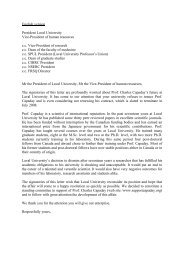Untitled - Laboratory of Neurophysics and Physiology
Untitled - Laboratory of Neurophysics and Physiology
Untitled - Laboratory of Neurophysics and Physiology
You also want an ePaper? Increase the reach of your titles
YUMPU automatically turns print PDFs into web optimized ePapers that Google loves.
50:3171–3190<br />
• Hawkes (1971), Point Spectra <strong>of</strong> Some Mutually Exciting Point Processes, Journal <strong>of</strong> the Royal<br />
Statistical Society Series B 33(3):438–443<br />
• Helias et al. (2011), Towards a unified theory <strong>of</strong> correlations in recurrent neural networks, BMC<br />
Neuroscience 12(Suppl 1):P73<br />
• Helias et al. (2013), Echoes in correlated neural systems, New Journal <strong>of</strong> Physics 15(2):023002<br />
• Moreno-Bote & Parga (2006), Auto- <strong>and</strong> crosscorrelograms for the spike response <strong>of</strong> leaky<br />
integrate-<strong>and</strong>-fire neurons with slow synapses, PRL 96:028101<br />
• Ostojic et al. (2009), How Connectivity, Background Activity, <strong>and</strong> Synaptic Properties Shape<br />
the Cross-Correlation between Spike Trains, J Neurosci 29(33):10234–10253<br />
• Renart et al. (2010), The Asynchronous State in Cortical Circuits, Science 327(5965):587–590<br />
• Shadlen & Newsome (1998), The variable discharge <strong>of</strong> cortical neurons: implications for connectivity,<br />
computation, <strong>and</strong> information coding, J Neurosci 18:3870–96<br />
• Tetzlaff et al. (2012), Decorrelation <strong>of</strong> neural-network activity by inhibitory feedback, PLoS<br />
Comp Biol 8(8):e1002596, doi:10.1371/journal.pcbi.1002596<br />
• Zohary et al. (1994), Correlated Neuronal Discharge Rate <strong>and</strong> Its Implications for Psychophysical<br />
Performance, Nature 370:140–143<br />
T3<br />
Modeling <strong>and</strong> interpretation <strong>of</strong> extracellular potentials<br />
Space Grignard, (9.00-12.20; 13.30-16.50)<br />
Gaute T Einevoll, Norwegian University <strong>of</strong> Life Sciences, Ås, Norway<br />
Szymon Leski, Nencki Institute <strong>of</strong> Experimental Biology, Warsaw, Pol<strong>and</strong><br />
Espen Hagen, Norwegian University <strong>of</strong> Life Sciences, Ås, Norway<br />
While extracellular electrical recordings have been the workhorse in electrophysiology, the interpretation<br />
<strong>of</strong> such recordings is not trivial. The recorded extracellular potentials in general stem from a<br />
complicated sum <strong>of</strong> contributions from all transmembrane currents <strong>of</strong> the neurons in the vicinity <strong>of</strong><br />
the electrode contact. The duration <strong>of</strong> spikes, the extracellular signatures <strong>of</strong> neuronal action potentials,<br />
is so short that the high-frequency part <strong>of</strong> the recorded signal, the multi-unit activity (MUA),<br />
<strong>of</strong>ten can be sorted into spiking contributions from the individual neurons surrounding the electrode.<br />
However, no such simplifying feature aids us in the interpretation <strong>of</strong> the low-frequency part, the local<br />
field potential (LFP). To take a full advantage <strong>of</strong> the new generation <strong>of</strong> silicon-based multielectrodes<br />
recording from tens, hundreds or thous<strong>and</strong>s <strong>of</strong> positions simultaneously, we thus need to develop new<br />
data analysis methods grounded in the underlying biophysics. This is the topic <strong>of</strong> the present tutorial.<br />
In the first part <strong>of</strong> this tutorial, we will go through<br />
• the biophysics <strong>of</strong> extracellular recordings in the brain,<br />
39



